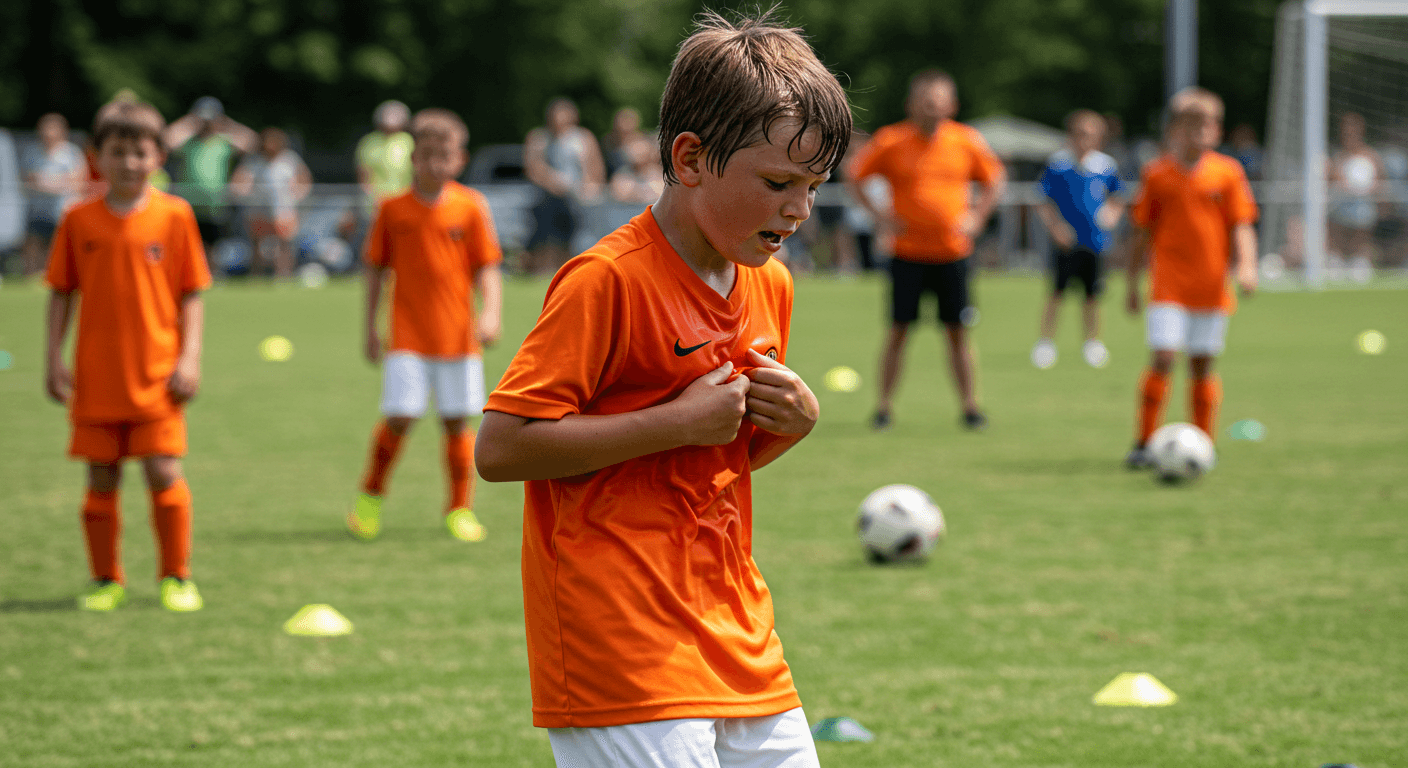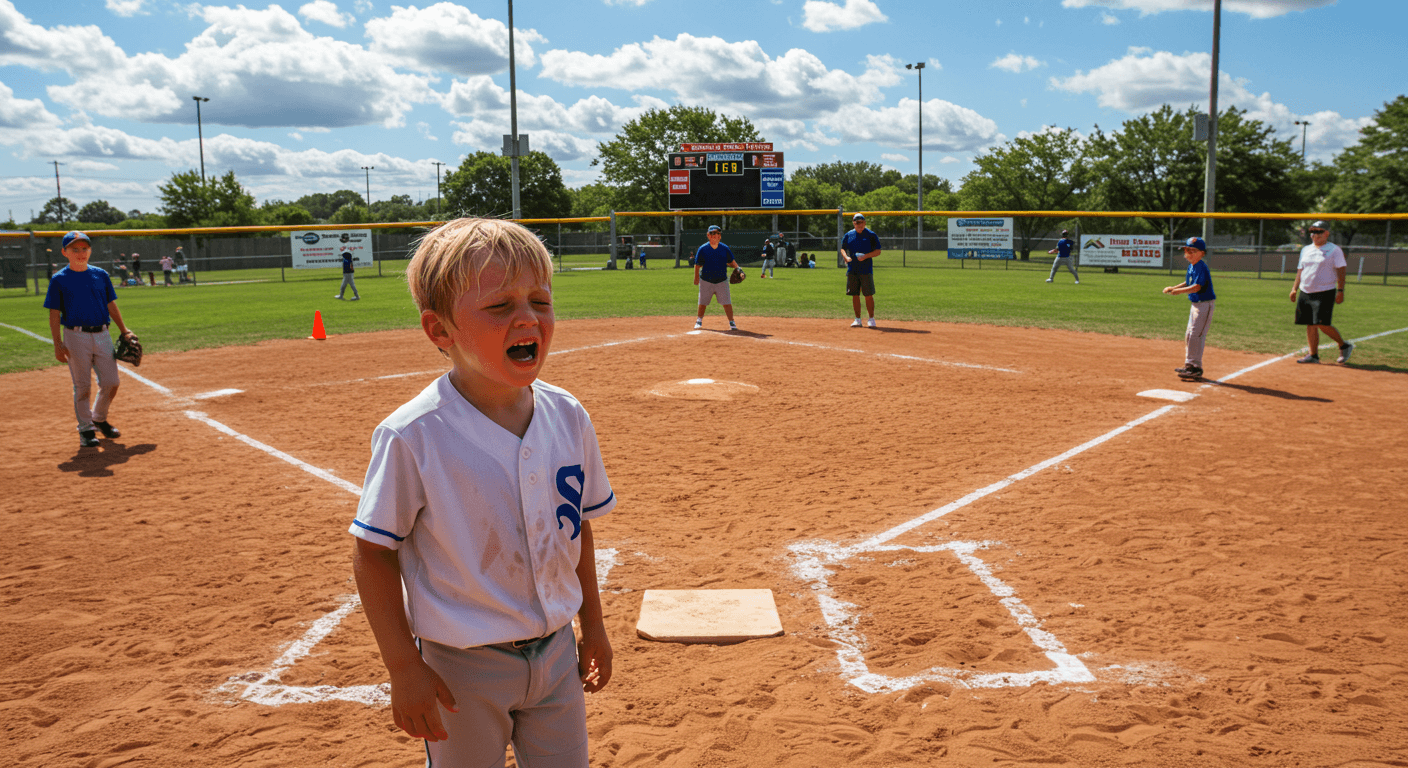Playing sports helps kids develop their confidence, teamwork, and physical fitness. However, youngsters are more likely to overheat during outside activities, games, and practice when the temperature rises. Children are more susceptible to heat-related illnesses, including dehydration, heat exhaustion, and even heatstroke, because they struggle to control their body temperature like adults do. To keep young athletes safe, it is essential for parents, coaches, and other caregivers to recognize the warning symptoms.
Children can rapidly become overheated, particularly in hot and muggy conditions. The risk is increased by lengthy practices, bulky equipment, and insufficient water breaks. Ignoring the early signs of mild overheating can have hazardous repercussions, even though it may merely cause pain. Therefore, one of the best methods to keep your child safe during sports is to be aware of the behavioral and physical symptoms of heat stress.
Excessive perspiration, flushed skin, or dizziness complaints could be some of the initial signs. Overheating needs to be treated right away because it can worsen into nausea, disorientation, or fainting if ignored. Early detection of these indicators enables coaches and parents to step in before things get out of hand.
Ten major indicators that your child might be overheating during sports are covered in this tutorial. Along with preventive techniques to help your child stay safe, hydrated, and healthy while staying active, you’ll also learn what to do in the event that your child exhibits these symptoms. Even in the midst of summer, sports can be enjoyable and safe if the proper information and planning are in place.
Why Children Are More Vulnerable to Overheating
Due to the way their bodies react to heat, children are more likely than adults to overheat while participating in sports. One of the primary causes is that children absorb more heat from their surroundings due to their higher surface-area-to-body-mass ratio. Additionally, they are less effective at releasing heat through perspiration, which makes it more difficult for them to naturally cool down.
Hydration is another factor. It is common for young athletes to consume insufficient amounts of water prior to, during, or following physical activity. Additionally, they might disregard early indicators of thirst, which raises the possibility of dehydration. The body’s capacity to control its temperature can be compromised by even mild dehydration, increasing the risk of overheating.
Sports settings are also important. The body becomes more stressed when engaging in strenuous physical activity in hot and muggy conditions. Wearing heavy uniforms or protective gear, such as football pads or catchers’ equipment, further traps heat and prevents air circulation. Without regular breaks, the body quickly becomes overwhelmed.
Children may also struggle to detect or convey when they are feeling hot. They can continue pushing themselves throughout a game or practice, dismissing early signals of exhaustion or discomfort. This is why it’s crucial for parents and coaches to monitor closely for warning symptoms of heat stress.
Understanding these vulnerabilities underscores the significance of monitoring youngsters during sports, ensuring hydration, and offering relaxation in cooler locations. With awareness and preventive steps, the dangers of overheating can be considerably decreased.
10 Signs Your Child Is Overheating

1. Excessive Sweating
Sweating is the body’s natural mechanism to cool down, but in youngsters, excessive sweating during sports can be an early warning of overheating. If your child’s clothing is wet through or sweat is streaming frequently, their body is trying to keep up with the heat. This is especially concerning if the weather is not extremely hot, meaning the child’s internal temperature is rising faster than expected. While sweating alone isn’t always dangerous, when paired with fatigue or dizziness, it signals that the body is under stress. Parents and coaches should encourage hydration and provide shade breaks immediately.
2. Red or Flushed Skin
Another clear indicator of overheating is red or flushed skin. When the body temperature rises, blood flow increases to the skin’s surface to release heat, making the skin appear bright red. Heat stress is indicated by persistent redness accompanied by heavy perspiration or irritability, even though flushed cheeks, neck, or arms during physical activity may appear normal. The skin may occasionally feel warm to the touch. The child may be developing heat exhaustion if the redness does not go away after resting and drinking plenty of water. Applying cool cloths and moving to a cooler location can help control body temperature.
3. Lightheadedness or dizziness
One of the more alarming early signs of childhood overheating is dizziness. A child may experience sudden unsteadiness, stumble, or complain of lightheadedness while participating in sports. This typically occurs as a result of heat and dehydration decreasing the blood supply to the brain. If body temperature keeps rising, ignoring this sign may result in fainting or collapse. Dizziness should never be disregarded, even though kids frequently attempt to persevere. If this occurs, the kid should immediately cease playing, sit or lie down in a shaded area, and gently rehydrate with water or an electrolyte drink.
4. Headaches
Headaches are a common sign that your child may be overheating during sports. When body temperature rises, blood vessels expand, and dehydration further reduces the brain’s access to necessary fluids, often resulting in a throbbing headache. A child might complain about pressure in their head, sensitivity to light, or difficulty concentrating. While headaches can have various origins, when they occur during hot, strenuous activity, they should be treated as a potential heat-related concern. Encouraging the youngster to rest in a cool area, sip water, and take a little break can often cure the headache before it worsens into heat exhaustion.
5. Nausea or Vomiting
Nausea and vomiting are red-flag signs of overheating and frequently suggest that the body is trying to cope with high heat stress. During sports, a youngster may suddenly feel nauseated, complain of stomach ache, or even vomit after strong activity in hot weather. This happens because temperature and dehydration disturb the digestive system. Unlike modest symptoms such as perspiration, nausea, signals to a more dangerous stage of heat exhaustion. If vomiting happens, the child should stop all activity immediately, rest in a shady or air-conditioned setting, and rehydrate carefully. Prolonged symptoms necessitate immediate medical care.
6. Muscle Cramps
Muscle cramps, particularly in the legs, arms, or abdomen, might be an early symptom of heat-related suffering. These cramps arise when dehydration and electrolyte depletion affect normal muscular function. Children engaging in sports that involve repetitive activity, like soccer, basketball, or swimming, are more prone to heat cramps. A youngster could suddenly clutch at a muscle or say that it feels tight and unpleasant. A pause from activity, stretching, and hydration with electrolyte-rich fluids typically assists. However, ignoring cramps can raise the chance of developing a more serious case of heat illness.
7. Unusual Weakness or Fatigue
It’s common to feel exhausted after doing sports, but extreme or abrupt exhaustion during an activity could be an indication of overheating. Your child’s body may be indicating heat stress if they appear weaker than normal, slow down significantly, or have trouble keeping up with teammates. Muscles have less energy when the body has to work harder to maintain a normal temperature due to overheating. A child may feel exhausted or unable to continue as a result of this. Restoring energy is frequently aided by rest, drinking plenty of water, and finding a cooler or shaded area. However, ignoring unusual weakness raises the risk of heatstroke or exhaustion.
8. Confusion or Irritability
Serious signs of overheating include behavioral changes like irritability, mood swings, or confusion. The brain of a child may not be getting enough oxygen and water if they exhibit unusually high levels of irritability, difficulty following instructions, or confusion when participating in sports. Because it indicates that body temperature is approaching dangerous levels, confusion is especially worrisome. Coaches and parents should never write off abrupt shifts in awareness or attitude as “fatigue.” Rather, the child should be taken out of play right away, kept under close observation, and cooled with rest, water, and shade. Medical attention is necessary if confusion continues.
9. Passing out or collapsing
One of the most serious indicators that your child is overheating while playing sports is fainting. It occurs when the body can no longer regulate blood pressure and temperature effectively, often due to dehydration, reduced blood flow to the brain, and extreme heat stress. A child may suddenly lose consciousness or collapse on the field. This is a medical emergency and requires quick attention. Move the child to a cool place, elevate their legs slightly, and call for medical help right away. Do not allow the child to resume activity until cleared by a healthcare professional.
10. Rapid Heartbeat or Breathing
An unusually fast heartbeat or rapid breathing during sports can be a sign that the body is under heat stress. As internal temperature rises, the heart works harder to circulate blood, and the lungs strain to bring in more oxygen. If your child appears to be breathing heavily while at rest, or their heartbeat looks faster than normal, overheating may be the culprit. This symptom commonly arises accompanied by dizziness, weakness, or nausea. Immediate cooling, hydration, and rest are critical. If symptoms do not improve quickly, a professional medical evaluation is necessary to prevent serious complications.
Conclusion

Sports are an excellent way for children to stay active, build confidence, and enjoy teamwork, but overheating can turn a fun activity into a dangerous situation quickly. Recognizing the early warning signs, such as excessive sweating, flushed skin, or dizziness, gives parents and coaches the chance to intervene before symptoms escalate. More severe indicators like nausea, confusion, fainting, or a rapid heartbeat should always be treated as emergencies.
Children are more vulnerable to overheating because their bodies are less efficient at cooling down. This makes it vital for adults to stay aware throughout practices, games, and outdoor activities, especially in hot and humid weather. Hydration, regular breaks, access to shade, and proper sports gear all play an important role in prevention.
Keeping children safe in the sun entails balancing physical activity with awareness and planning. With the correct safeguards, sports may remain a fun, healthful activity while decreasing the risks of overheating.
